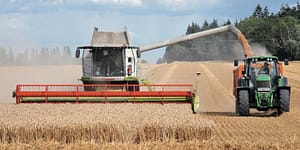Mini-Forest Revolution: An Interview With Hannah Lewis

The Miyawaki Method, a unique approach to reforestation devised by Japanese botanist Akira Miyawaki, is recently seeing a worldwide surge in popularity. Miyawaki-style mini-forests are very biodiverse and come with a myriad of environmental benefits. These tiny forests have the potential to cool urban heat islands, establish wildlife corridors, build soil health, sequester carbon, create pollinator habitats, and much more.
In Mini-Forest Revolution, author Hannah Lewis explores this method and shares the stories of mini-forests that have sprung up across the globe. Today, she is known as forest maker turning asphalt into ecosystems to save the planet; and she wants everyone to know they can do it, too.
The following interview with Hannah Lewis, author of Mini-Forest Revolution, has been adapted for the web.
Featured image courtesy of Dan Grady.
Chelsea Green Publishing: What inspired you to write Mini-Forest Revolution and why do you think this topic is so important?
Hannah Lewis: My motivation to write the book and to lead a mini-forest planting myself were inseparable from each other, and pretty close to what motivated the others featured in the book to embrace the Miyawaki Method. For me, it has been a positive way to transform grief and concern over our languishing planet, over all the species being lost, and over all the individuals suffering – into action that can slow those processes down, at least locally. Planting a mini-forest is a way to express love for this world, and writing the book seemed like a good way to explain how and why. And both projects were a lot of fun!
My goal for the book is to encourage readers to reconsider our relationship to wildlife by more clearly seeing our interdependence with other species. Did you know that phytoplankton and seaweed in the ocean produce most of the oxygen we breathe? And those plankton depend on sperm whales for their nourishment, which means we depend whales. So rather than tolerating things like noise pollution, plastic pollution, increasing vessel traffic, and overfishing of the oceans that harm whales and other ocean life, we should be doing everything possible to make those species flourish.
The whales-plankton connection is just one of millions of species interactions happening outside the human realm that sustain us. The point is that while we can probably survive without our cell phones, cars, or refrigerators, we cannot live too long without the web of relationships that results in oxygen production, clean water, healthful food, and milder weather patterns. Planting mini-forests is a way to nurture a section of the greater web of life, which in turn supports our lives in more ways that we can imagine through interdependencies to which we are generally blind. I hope the book prompts readers to start removing our blinders.
CGP: What exactly is a “mini-forest” and how did Japanese botanist Akira Miyawaki revolutionize it?
HL: A mini-forest is an ecologically robust native forest grove that can be planted by kids and families in schoolyards, churchyards, road verges, parks, and other small spaces around where we live and work. It’s a landscaping approach whose goal is not only beautification, but also ecosystem regeneration, buffering against extreme weather, and reconnecting people to nature, and it’s catching on across the world.

Torkaman’s farm mini-forest in 2021, after nearly five years of growth. Courtesy of Bahram Torkaman.
It’s a way to grow natural, mature forests in a couple of decades rather than a couple of centuries. You do this by observing what happens in nature. When bare ground is left undisturbed for many decades or centuries, plants grow into the space in successive waves of increasingly larger, longer-living, and more shade-tolerant vegetation, each group replacing the previous group. This process ultimately results in a stable, mature forest in places where the climate is suitable for such. The Miyawaki Method anticipates what would grow in that ultimate forest community and plants those species directly.
In addition to guiding the choice of species – which will include not only large canopy trees but also smaller trees and shrubs, the Miyawaki Method also calls for intensively preparing the soil, planting densely, heavily mulching, and actively maintaining the site for the first 3 years as the forest becomes established. By the end of 3 years, the young trees will have formed a thick enough canopy to shade out weeds and create a micro-climate that protects the interior from weather extremes. So, by this time a forest planted this way is self-sufficient, needing no maintenance ever again.
CGP: Your book discusses multiple Miyawaki forestation projects in several countries. How can you explain the growing popularity of Miyawaki-style forests in very different contexts? Do motivations vary in different regions of the world?
HL: The motivations do vary according to the local context. Cities across the Netherlands are motivated to connect children to nature. In the Yakama Nation in Washington State, the mini-forest is part of a rehabilitation program for correctional facility residents, while the Miyawaki Method planting along the Sendai coast in Japan is designed as a forest seawall to defend communities against future tsunamis. But if you dig just a little deeper, I think the motivation is the same everywhere. People are increasingly alarmed by global biodiversity loss and climate breakdown, and the Miyawaki Method offers a valid and accessible way to support nature and wildlife as a buffer against both crises.
CGP: In the title of your book, what do you mean by mini-forest “revolution”?
HL: There are two meanings for the word “revolution” in this context. The first refers to the fast spread and adoption of the Miyawaki Method over the past 5-10 years. It’s appealing to people everywhere as we come to grips with the severity of the climate and biodiversity crises, and can see how they are intertwined. The Miyawaki Method strikes many is a meaningful and accessible way to respond locally to both of these global problems.
The other significance of “revolution” in reference to the Miyawaki Method is that it offers a completely new approach to urban landscaping. Instead of planting trees and shrubs in isolation from one another, often with aesthetics as a primary consideration, the Miyawaki Method plants trees in relation to other species and in a way that fosters the development of a native forest community. This creates mutually beneficial interactions among organisms, rendering them more productive and resistant to stress than they would be alone and fending for themselves. The explicit goal of the Miyawaki Method is ecosystem regeneration, not ornamentation, although an important outcome is also beautification of an area.
CGP: Will the Miyawaki Method work in any climate anywhere in the world?
HL: The method is applicable anywhere where the primary vegetation is forest. The Miyawaki Method was designed in the temperate climate of Japan, and that is where it has the longest track record of success. However, Miyawaki also planted forests in tropical regions, and the method has been successfully tested in Mediterranean climates as well. The key is to figure out what would be growing on a site if it had not been cleared for development, and to recreate that. So, for instance in the Great Plains, where the historical vegetation is prairie, wooded areas are mainly found along streams and rivers, which is where the Miyawaki Method would be a good fit rather than replacing prairie.
CGP: If the Miyawaki Method recommends planting a site’s historical vegetation, how does it account for a changing climate? Shouldn’t warmer-climate species be considered in the planting mix?
HL: The Miyawaki Method specifically advises us to plant the climax vegetation for a given site under current climate conditions (not past or future climates). We use the historical vegetation as a starting point because the species that were here a few hundred years ago are still largely the best fit. The goal is to grow a functional healthy ecosystem now. We need those spaces to provide wildlife refuge now, draw down carbon now, clean the air now. Furthermore, when we plant native forest, we boost the seed stock and connectivity, and thus the potential for these species to migrate northward on their own.
CGP: The Miyawaki method is often implemented collaboratively, by citizen collectives, teams of volunteers, etc. Would you say that community-building and engagement are essential elements or outputs of successful Miyawaki-style forest-making?

Miyawaki’s Yokohama National University forest was at least forty years old when this picture was taken in 2019. Courtesy of Kazue Fujiwara.
HL: Yes, community engagement is absolutely a core element of the Miyawaki Method. The method lends itself to intergenerational public participation because the plants are small, lightweight, and easy to plant even for a small child. Also, because there are so many plants, it takes a lot of people to get the job done!
Miyawaki himself organized “planting festivals” for forest making that very deliberately put communities at the center of the process. These festivals got started with a call-and-response “naming ceremony” in which everyone gathered would call out and repeat the names of the main tree species they were about to plant – to learn the names and be able to recognize the species. In his prolific writing and speaking, Miyawaki made it clear that people are part of nature, that our wellbeing depends on the wellbeing of ecosystems, and that we have a responsibility toward one another to take care of nature. So, naturally, people should be involved in forest-making.
The new groups around the world have been drawn to the Miyawaki Method in large part because of its participatory nature. In general, these groups haven’t missed a beat in terms of integrating the community aspect into their processes.
CGP: Are mini-forests really a climate solution, given how small they are?
HL: A wise person once said: A small act is not so small if millions of people are doing it!
Recommended Reads
Recent Articles
Oxeye daisies are one of the most important plants for pollinators including beetles, ants, and moths that use oxeye daisies as a source of pollen and nectar. Instead of thinking about removing a plant like oxeye daisy, consider how you can improve the fertility and diversity of habitat resources in your home landscape, garden, or…
Read MoreThis long-lived perennial legume is used for forage and erosion control. Kudzu is edible with many medicinal uses and other applications. Pollinators of all kinds love its prodigious lavender blooms!
Read MoreMove aside, maple! We have two new syrups to add to the table. Read on for insights on tapping, selling, and eating syrup from walnut & birch trees.
Read MoreWhy is modern wheat making us sick? That’s the question posed by author Eli Rogosa in Restoring Heritage Grains. Wheat is the most widely grown crop on our planet, yet industrial breeders have transformed this ancient staff of life into a commodity of yield and profit—witness the increase in gluten intolerance and ‘wheat belly’. Modern…
Read MoreDid you ever wonder how leeks, kale, asparagus, beans, squash, and corn have ended up on our plates? Well, so did Adam Alexander, otherwise known as The Seed Detective. The following is an excerpt from the The Seed Detective by Adam Alexander. It has been adapted for the web. My Seed-Detective Mission Crammed into two…
Read More










